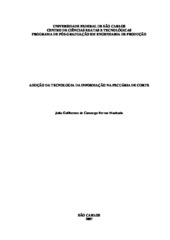Adoção da tecnologia da informação na pecuária de corte

View/
Date
2007-05-10Author
Machado, João Guilherme de Camargo Ferraz
Metadata
Show full item recordAbstract
Information Technology (IT) starts to play an important role in the day-by-day, changing the
way the cattlemen manage their properties. IT affects business management as it allows for
search, access, storage and dissemination of information, improving the decision-making
process. Besides softwares and agribusiness websites, IT includes electronic devices for
storage of sanitary, nutricional and genetic information; television channels and
telecommunications structure. This research aimed to study the use and the diffusion of IT in
the beef cattle breeding, from the analysis of the factors that have influenced its adoption; to
describe resources, procedures and necessary actions for IT operation; to segment (classify)
rural enterprises by their technological level; and to elaborate suggestions to intensify the IT
uses in the cattle breeding business. The research was performed in two stages, quantitative
and qualitative. In the first stage, a survey with producers was performed. Information
concerning the different technologies adopted and the attitudes taken with IT, enabled to
identify the level of innovativeness of producers. It was possible to classify them by the
similarities of the technological position. The second stage analyzed experiences, opinions
and perspectives regarding the technology integrated to the productive system. Two properties
were analyzed by each category, totalizing ten case studies, by personal interviews. The
results indicated the reasons of the adoption or rejection of a certain IT by the producers,
allowing for the identification of the reasons why some producers have adopted it more
quickly than others. It was possible to understand the modifications in the rural organization
due to IT adoption, as, for example, improvement in managerial skills. Altogether, the
processes have been improved and became easier, with positive consequences in several
areas, including human resources and the enterprise s image in the market.